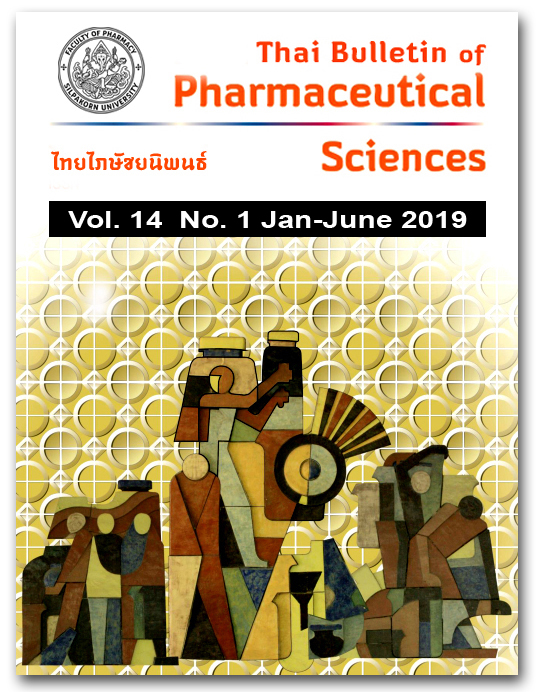POLYMERIC MICELLES FOR TUMOR TARGETING
DOI:
https://doi.org/10.14456/tbps.2019.2Keywords:
polymeric micelles, passive tumor targeting, active tumor targetingAbstract
Current chemotherapy for cancer encounters several problems such as non-selectivity of cancer cells, toxicity to healthy cells and multidrug resistance (MDR). Polymeric micelles (PMs) are selected as anticancer drug nanocarriers due to predominant characteristics such as being able to enhance the aqueous solubility of hydrophobic anticancer drugs, reduce the particle size of nanoscales, reduce the toxic side effects of chemotherapy, reduce the recognition of PMs by reticuloendothelial systems (RES), their stability in plasma, prolonged blood circulation, and eventually, accumulation in the required tumor sites. Furthermore, PMs can reach tumor sites using two mechanisms - both passive and active. For passive tumor targeting, PMs are delivered to solid tumor through the enhanced permeability and retention (EPR) effect while active tumor targeting aims to increase anticancer drug delivery to the targeted sites utilizing biologically specific interaction by coupling specific ligands on the micelle surfaces. Various ligands have been conjugated with PMs such as antibodies, folic acids, transferrins, etc. Moreover, the application of stimuli such as pH and temperature facilitate delivery of PMs to tumor sites. This review article summarizes available information related to definition of PMs, polymer used, formation of PMs, drug release from PMs and anticancer drug-loaded PMs for tumor targeting via passive and active mechanisms
References
2. Kedar U, Phutane P, Shidhaye S, Kadam V. Advances in polymeric micelles for drug delivery and tumor targeting. Nanomedicine. 2010;6:714-29.
3. Wicki A, Witzigmann D, Balasubramanian V, Huwyler J. Nanomedicine in cancer therapy : challenges, opportunities, and clinical applications. J Control Release. 2015;200:138-57.
4. Biswas S, Kumari P, Lakhani PM, Ghosh B. Recent advances in polymeric micelles for anti-cancer drug delivery. Eur J Pharm Sci. 2016;83:184-202.
5. Opanasopit P. Targeted drug delivery systems. Nakhon Pathom: Silpakorn University Press; 2015. p.145-66. (in Thai)
6. Lu Y, Park K. Polymeric micelles and alternative nanonized delivery vehicles for poorly soluble drugs. Int J Pharm. 2013;453:198-214.
7. Gokulgandhi MR, Patel A, Cholkar K, Barot M, Mitra AK. Nanoscale drug delivery systems. In: Mitra AK, Lee CH, Cheng K, editors. Advanced drug delivery. Hoboken (NJ): John Wiley & Sons; 2014. p.141-51.
8. Lui DZ, Hsieh JH, Fan XC, Yang JD, Chung TW. Synthesis, characterization and drug delivery behaviors of new PCP polymeric micelles. Carbohydr Polym. 2007;68:544-54.
9. Perez-Herrero E, Fernandez-Medarde A. Advanced targeted therapies in cancer: drug nanocarriers, the future of chemotherapy. Eur J Pharm Biopharm. 2015;93:52-79.
10. Oerlemans C, Bult W, Bos M, Storm G, Nijsen JFW, Hennink WE. Polymeric micelles in anticancer therapy: targeting, imaging and triggered release. Pharm Res. 2010;27:2569-89.
11. Upreti M, Jyoti A, Sethi P. Tumor microenvironment and nanotherapeutics. Transl Cancer Res. 2013;2:309-19.
12. Danhier F, Feron O, Préat V. To exploit the tumor microenvironment: passive and active tumor targeting of nanocarriers for anti-cancer drug delivery. J Control Release. 2010;148:135-46.
13. Cabral H, Matsumoto Y, Mizuno K, Chen Q, Murakami M, Kimura M, et al. Accumulation of sub-100 nm polymeric micelles in poorly permeable tumours depends on size. Nat Nanotechnol. 2011;6:815-23.
14. Torchilin VP, Lukyanov AN, Gao Z, Papahadjopoulos-Sternberg B. Immunomicelles: Targeted pharmaceutical carriers for poorly soluble drugs. Proc Natl Acad Sci U S A. 2003;100(10): 6039-44.
15. Zhang Y, Zhang H, Wu W, Zhang F, Liu S, Wang R, et al. Folate-targeted paclitaxel-conjugated polymeric micelles inhibits pulmonary metastatic hepatoma in experimental murine H22 metastasis models. Int J Nanomedicine. 2014;9:2019-30.
16. Sahoo SK, Labhesetwar V. Enhanced antiproliferative activity of transferrin-conjugated paclitaxel-loaded nanoparticle is mediated via sustained intracellular drug retention. Mol Pharm. 2005;2:373-83.
17. Dharap SS, Qiu B, Williams GC, Sinko P, Stein S, Minko T. Molecular targeting of drug delivery systems to ovarian cancers by BH3 and LHRH peptides. J Control Release. 2003;91:61-73.
18. Zeng F, Lee H, Allen C. Epidermal growth factor-conjugated poly(ethylene glycol)-block-poly(delta-valerolactone) copolymer micelles for targeted delivery of chemotherapeutics. Bioconjug Chem. 2006;17:399-409.
19. Kabanov AV, Alakhov VY. Micelles of amphiphilic block copolymers as vehicles for drug delivery. In: Alexandridis P, Lindman B, editors. Amphiphilic block copolymers: self assembly and applications. Amsterdam: Elsevier; 2000. p.347-76.
20. Liu Y, Wang W, Yang J, Zhou C, Sun J. pH-sensitive polymeric micelles triggered drug release for extracellular and intracellular drug targeting delivery. Asian J Pharm Sci. 2013;8:159-67.
21. Tian L, Bae YH. Cancer nanomedicines targeting tumor extracellular pH. Colloids Surf B Biointerfaces. 2012;99:116-26.
22. Lee ES, Oh KT, Kim D, Youn YS, Bae YH. Tumor pH-responsive flower-like micelles of poly(L-lactic acid)-b-poly(ethylene glycol)-b-poly(L-histidine). J Control Release. 2007;123:19-26.
23. Lee RS, Lin CH, Aljuffali IA, Hu KY, Fang JY. Passive targeting of thermosensitive diblock copolymer micelles to the lungs: synthesis and characterization of poly(N-isopropylacrylamide)-block-poly(?-caprolactone). J Nanobiotechnology. 2015;13:42.
24. Chung JE, Yokoyama M, Yamato M, Aoyagi T, Sakurai Y, Okano T. Thermo-responsive drug delivery from polymeric micelles constructed using block copolymer of poly(N-isopropylacrylamide) and poly(butylmethacrylate). J Control Release. 1999;62:115-27.
25. Blanco E, Shen H, Ferrari M. Principles of nanoparticle design for overcoming biological barriers to drug delivery. Nat Biotechnol. 2015;33:941-51.
Downloads
Published
Issue
Section
License
All articles published and information contained in this journal such as text, graphics, logos and images is copyrighted by and proprietary to the Thai Bulletin of Pharmaceutical Sciences, and may not be reproduced in whole or in part by persons, organizations, or corporations other than the Thai Bulletin of Pharmaceutical Sciences and the authors without prior written permission.


